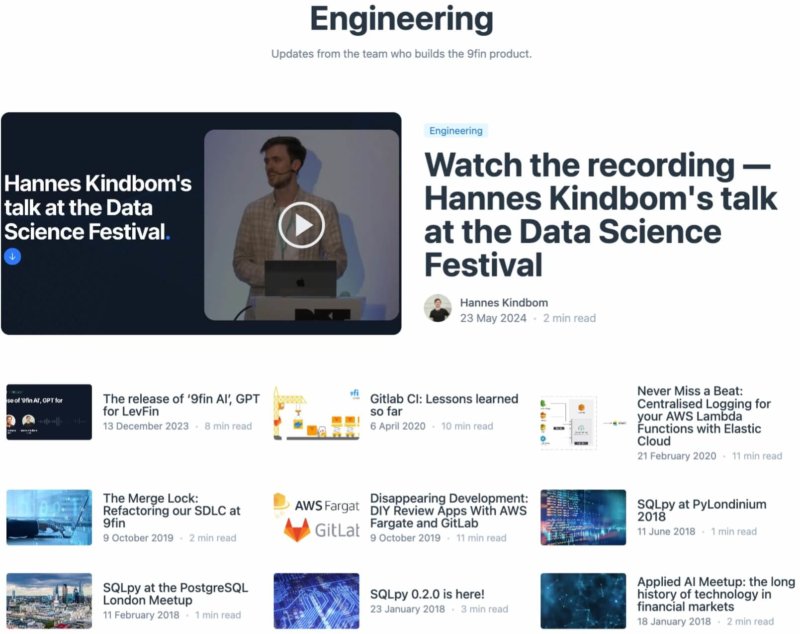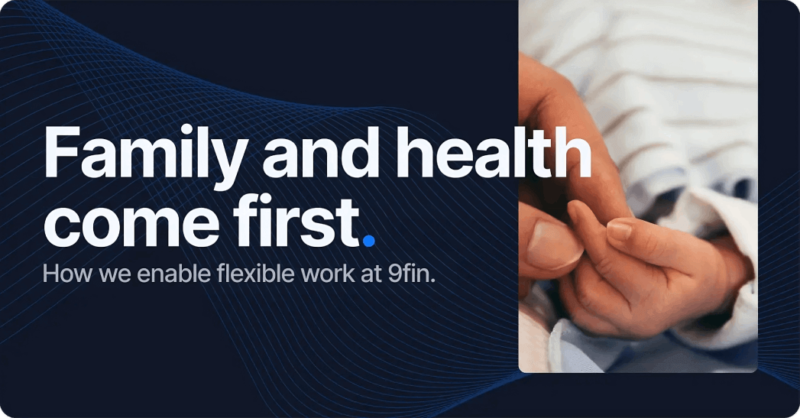27 June 2024
Huss El-Sheikh of 9fin explains how a technical founder catches engineering talent
Technology professionals on a job hunt can have hundreds of companies to swipe through. Huss, the co-founder and CTO of 9fin, suggests your best bet is to present what’s great on the inside. But someone has to do the work — and company culture must be strong.
The CTO vs Status Quo series studies how CTOs challenge the current state of affairs at their company to push it toward a new height … or to save it from doom.
Huss earned his degree in Aerospace Engineering from the University of Bristol.
As we talked, he recalled a professor who warned the class not to complain that the subject was tough.
“If you get it wrong, everybody dies” — the professor’s words stay locked in Huss’ mind even today.
While he now works in the relatively safer space of debt market intelligence, his scientific thinking helped him and his co-founder design a fintech with an employee culture that attracts top talent.
From this interview, you’ll learn what actions resulted in 9fin’s growth to over 200 employees in six years.
Huss explains:
- how clichés like coding challenges or event talks can actually work,
- why engineering must co-create marketing materials to support recruitment,
- why talent acquisition should be measured like any proper business process.
About Huss & 9fin
Bio
Huss has been coding since his childhood, but his first foray into the corporate finance world was with Deutsche Bank, first as an intern and then as a business analyst.
He climbed up the ranks in four years to become associate VP, and his business knowledge combined with a tech-focused mindset set him on the path to co-founding 9fin.
Since its conception in 2016, 9fin has led the market with its intuitive, AI-enabled platform, and grown to over 200 employees across three offices in London, New York, and Belfast.
Expertise
Programming, business analysis, data analysis
Hobbies
Robotics, skiing, technology and engineering, staying active
9fin
9fin is the faster, smarter way to find debt market intelligence. We have everything you need to analyse a credit or win a mandate in one place. At 9fin we’re trusted by nine of the top 10 investment banks, asset management firms with a total of over $17trn of AUM, and 80% of trading desks by estimated European High Yield volume.
At 9fin, we use AI to consume, organise, and understand the world’s fixed-income financial data. This allows you to:
– Spot new deals before they happen. Our data predicts refinancing, restructuring, and capital markets activity up to 12 months before it happens.
– Have the most comprehensive market intelligence delivered directly to your inbox. Aggregated from more than 2,000 sources, giving you vital insight before anyone else.
– Read covenant analysis that allows you to understand complex legal risks in seconds – not days.
– Search, filter, and analyse key information from bond and loan documents with our AI-powered search capabilities.
Hiring strategy vs startup growth
Eric Ignasik: As co-founder of 9fin, could you tell us which processes must be set up and protected for a company to attract the best possible talent?
I’m a first-time founder, so my co-founder and I learned many things from trying, as opposed to following a playbook. I don’t think there’s a ‘one size fits all’ approach to landing your first hire at a small company.
Your hiring process might not exist for the first year or two.
The company is still unknown to most, and only a few apply to open roles, so you don’t need a stringent process with funnels and conversion targets. You’ll be able to spend a lot of time with those who do seek you out and get to know them more.
With 9fin, our first intern actually got in touch by messaging us through the chat bubble on the homepage. At the time, we just had a website and no actual product behind the landing page.
I think there are three startup stages for a first-time founder. You build the product, the business, and then the company.
The first stage involves a group of people solving a market problem.
At this point, posting a job offer on a startup job board or AngelList is enough to attract candidates who are already self-selecting into startups.
I also heard some early-stage startups with an open-source business model attract people who review or contribute to their products.
Then, the product needs to become self-sustainable – that’s the second stage. It needs to become a business. At this stage, the product is valid, and you’re trying to monetize it.
You have more clarity on the skills you need. Your startup’s job description will be sharper, and will contain the finer details that help you fill the gaps in your talent pool.
For the first couple of years, I actually spent half of my week regularly posting on job boards and sending messages.
At the third stage, the business starts to grow, and you’ll most likely focus on culture and hiring practices. This is usually the stage when founders have the breathing room to develop internal processes.
You consider the size and needs of your team, you partner with your C-suite colleagues, you listen to their requirements, and you contribute to building a hiring strategy for the first time.
It’s important to test different strategies for hiring with the support of the people and talent managers you hired at that time.
As a technology leader, I know when to jump in, and when to step back and supply the people and talent team with information that will help them reach the best candidate.
Could you give an example of a case study engineering candidates have to solve?
One engineering test we do involves candidates selecting the best components to complete a half-implemented screen or product. It’s a great way to understand how engineers think about various components, encapsulation, reuse, and testing.
I also like to hear how candidates think about their data as it goes through a system, all the way from the storage and persistence layer to the serving and performance layer.
At the interview, we might ask you about web servers. How do bits of information travel across the internet? What is the request-response model?
For data scientists, we might run a task which involves analysing and extracting key insights from a dataset. Candidates then have to present their findings to 9fin’s data science team.

Let’s look beyond recruitment. Can you take us through 9fin’s onboarding process for engineers and explain what makes it successful?
Every new joiner is met with a similar onboarding process that’s tailored to the team they’re joining.
The first stage is always the same. It includes a “day one” session with a people partner to get used to the systems we use daily and ensure they’re signed up to the right platforms.
We’ve just started a buddy system, so recruits are paired with someone who can offer guidance and answer their burning questions.
Then, over the weeks or months, there is a series of introductory talks for newcomers.
One meeting is with the product team to show how we build; another one is with sales to explain our commercial model and the customer types.
For engineers specifically, the new joiner’s team prepares tasks that help them build confidence and get familiar with the platform.
This is aligned with their 90-day onboarding plan, which they discuss with their managers on a regular basis.
Engineers join the same delivery team that gave them their first assignments. In their daily work, they’ll collaborate with a product manager, a designer, front-end engineers, back-end engineers, and a data scientist.
Perfect. So, it sounds like newcomers aren’t thrown into the deep waters of a project but have a gradual introduction.
Could you describe the changes you made to engineering in the last three years to support the recruitment of new hires?
We’ve recently introduced a coding test. It’s an effective way to identify motivated candidates if it’s used respectfully.
It’s also important to test both basic programming language proficiency and problem-solving skills in the earlier stages of the application process, as this saves time for everyone involved.
At first, like many other engineers, I had my reservations.
I thought coding puzzles were an unnecessary grind, and that everybody would prefer to debate a tech case study at the whiteboard instead.
But, to my surprise, a high rate of people completed the challenge, which we specifically designed to be solvable.
9fin’s secret weapon is to include engineers in the entire interview process beyond the skill-test phase.
It’s a great development mechanism for future senior engineers or team leads. Candidates also love to talk to other engineers they might work with. We’ve received great feedback about it.
What candidates respond to
What successful marketing or recruitment tactics helped 9fin find the best-fit candidates, such as Bruce Pannaman, who you hired recently?
Bruce joined as head of engineering at the end of 2023 and has been driving our recruitment efforts.
Socials are a great platform to showcase our culture, so candidates can learn more about what we’re like as a business.
9fin offers a centralized platform for debt market intelligence used by asset managers, investment banks, and law firms alike. It’s definitely a niche.
Our technology is very interesting, and we make sure we’re also highlighting that across our socials and our site.
There are videos of my talks from 2018 and 2019 that candidates manage to find and mention at interviews!
Aside from socials, in-person and virtual events also work well for us. Hannes Kindbom, our data science specialist, gave a talk at the Data Science Festival in London just a few weeks ago.
It was about the safety test and optimization of Retrieval Augmented Generation (RAG) systems, and he discussed the outcome, the infrastructure, cloud services, and the development behind it.
We do a lot of smart engineering work here at 9fin. I wish we had more time to publish stories of what we do. Luckily, that’s starting to change.
9fin has 11 values, which I think can be highly attractive for new recruits looking for a supportive environment.
How do you ensure these values are followed in each department?
Fun fact about these: we wrote our values a year before founding the company.
It felt like the best place to start if we wanted clarity on how this business should operate, who we should hire, and what the culture should look like.
My co-founder Steven Hunter and I were flatmates, working our 9-to-5 (more like 9-to-midnight for Steven) jobs at conservative, suit-and-tie financial companies in London.
Our jobs were rewarding and enjoyable, but they didn’t give us room for growth. Each value represents an element that was lacking at our workplaces at the time.
Some of my favorite 9fin values include “Family and health come first,” reminding you that work shouldn’t be your highest priority after you close your work laptop at the end of a day.
I also like “Technology is the business,” which suggests whatever we build is not a tool but a critical foundation for our clients’ operations.
We adopt our values using a top-down approach. By living these values, I hope we can see them filter through the business in everything we do.
For instance, we have both remote-first and hybrid policies available, which align with the value of putting family and health first.

(Real) culture and processes
Let’s carry on. Neil and Boyko, two other Technology Leaders we interviewed, noted they still contribute code to the product to earn the respect of other engineers.
What kind of team-building practices does 9fin have?
It’s important to hire engineering managers and give them the space to manage. As a technology leader, I made a decision to go into management – so I need to take a step back and ensure my time goes where it’s needed most.
At the same time, it’s important to welcome and encourage a hands-on approach. It helps strengthen relationships within the team, and gives everyone an equal footing.
Our engineering managers are still free to offer direct involvement, which happens regularly at our weekly meetings.
For example, Bruce Pannaman, our VP of Engineering, really enjoyed participating in hackathons at 9fin’s engineering conferences.
At one of these hackathons, we worked on upgrading our analytics, the metrics we record, and our stack.
Bruce had experience with this, so he was drawing out the architecture on the whiteboard with everyone else.
Some could argue that retention is more critical than recruitment.
What exactly does 9fin teach its engineering managers so that their subordinates want to work with them?
I agree. Retention is more important than recruitment, and it’s good to optimize your retention strategy.
There’s no ceiling that limits how much work can be done on a project.
We invest strongly in areas that teach engineers self-management from week one, so they’re not only contributing to a project but are also free to lead its technical direction if they want.
It’s another way to promote room for growth in the role, and strong learning and development opportunities within engineering.
I often hear that engineering managers dictate what architecture should be used when their job is to care for five or six people. We try to avoid that.
We also introduced a comprehensive system engineering managers use to understand what individual engineers want regarding career development.
The system includes feedback surveys and one-to-ones to make sure conversations about personal growth happen on a regular basis.
It’s up to the individual to decide how often they talk with their managers.
Some people want to connect every week, while others prefer a two-week cadence. It’s a good way of putting engineers in the driver’s seat when it comes to their career progression.
Good to remember
What are your three recommendations to other CTOs who want to support the recruitment efforts of their company?
Lean on your hiring managers. They know how to reach and encourage candidates.
Engineering leadership’s role is to give people and talent teams the information they need, whether it’s on the technology stack or the roadmap so that they can approach the most suitable hires.
I am still involved in the final stage of the hiring process for EMs.
Make sure you have a robust candidate tracking system.
I find this really useful – I can browse through the notes and get a feel for hiring progress, which is something we also recap in weekly meetings.
And as an extension to this, make sure your system allows for candidate feedback. You’ll want to know if applicants have a smooth time with the recruitment process.
I also believe the company should measure the hiring funnel’s performance. Everything can be refined, so make sure you improve your job descriptions, for example, by adding details on the tech stack. Test it to see if it works – and if it doesn’t, take it out.
My final tip is really close to my heart: Don’t lose hope.
There are many great engineers out there. Their experience may look good on paper, but they might decline your job offer after being interviewed or end up not being a good fit. This can happen several times in a row.
You could easily get into self-doubt then – is hiring meant to be this difficult? Am I being unrealistic?
Steven Hunter (9fin’s CEO and co-founder) calls this: “Forgetting what ‘yes’ looks like.”.
By mathematics, your company is one of the few thousand that might be hiring at any given time, and there are a few million software engineers out there. It’s okay not to have a 100% hiring success rate, you can’t fit everyone in.
Ultimately, the company and the candidate must see themselves as a match. That’s not easy to work out, but the key is to keep at it and not settle for less than what your business needs.
Resources
Everybody seems to recommend “Team Topologies” so much that Michael swore he’d read the book.
Which other books, podcasts, newsletters, or courses for Technology Managers would you recommend?
Someone also recommended “Team Topologies” to me. I’ve heard so many discussions about it that I feel like I’ve read it by proxy!
“Crossing the Chasm” is a must-read book for every CTO or technical co-founder. It focuses on the commercial side of business rather than software development.
I read it two years after I started the company and felt like it enlightened me about go-to-market (GTM) strategies at a company.
Since I’m an engineer at heart, how to do business was a mystery to me. Like many others, I thought a product should sell if we made it amazing. Of course, “Build it, and they’ll come” is untrue.
“Crossing the Chasm” really explains the psychology of sellers and buyers. It would definitely help engineers bridge the gap between their work and its relationship to the company’s commercial aspect.
My other recommendations include the “Pragmatic Engineer,” which has been my favorite source of technology culture stories over the years
Michael Loft’s blog is a good read for the nerdier of us. He’s a popular engineering management guru.
Julia Evans and Rachel Kroll also publish thoughtful programming and tech articles worth reading.
Finally, “High Scalability” is something I used to read every day when I was just “git commit” like everyone else. It had really stimulating deep dives into the architectures of different systems.
What’s next? Three actions for CTOs to take
The 11 values created by Huss and Steven seem to have supported all their recruitment efforts.
A pro-people policy that influences each managerial decision can create a work environment worth recommending — if the company proves to the public that it works.
But not all organizations are employee-centric by design. What then?
- Write down and promote your department’s best practices and projects on the outside — how are the applicants supposed to hear about them?
- Include cross-department training for newcomers that explains the business, the product, and the customers of it.
- Keep the engineers engaged by giving them enough autonomy since you need them motivated and probably don’t want to lose them.
May you not get discouraged by the “no”s you hear.
You could be a fit for 9fin
Huss is looking for Senior Software Engineers for a hybrid role in London. If you appreciate his philosophy, or if 9fin’s 11 values resonate with you, browse through their open roles.


